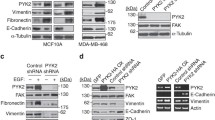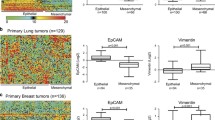Abstract
Epithelial to mesenchymal transition (EMT) is a process occurring during embryonic development and cancer progression. Using recepteur d'origine nantais (RON)-expressing epithelial cells as a model, we showed that RON activation causes spindle-shaped morphology with increased cell motilities. These activities resemble those observed in EMT induced by transforming growth factor (TGF)-β1 or by Ras–Raf signaling. By immunofluorescent and Western blot analyses, we found that constitutive RON expression results in diminished expression of E-cadherin, redistribution of β-catenin, reorganization of actin cytoskeleton, and increased expression of vimentin, a mesenchymal filament. RON expression is also essential for TGF-β1-induced expression of α-smooth muscle actin (α-SMA), a specialized mesenchymal marker. In the study of signaling pathways responsible for RON-mediated EMT, it was found that PD98059, a MAP kinase inhibitor, blocks the collaborative activities of RON and TGF-β1 in induction of α-SMA expression and restores epithelial cells to their original morphology. Moreover, we showed that RON expression increases Smad2 gene promoter activities and protein expression, which significantly lowers TGF-β1 threshold for EMT induction. These results suggest that persistent RON expression and activation cause the loss of epithelial phenotypes. These changes, collaborating with TGF-β1 signaling, could play a critical role in epithelial transdifferentiation towards invasiveness and metastasis of certain cancers.











Similar content being viewed by others
References
Batlle E, Sancho E, Franci C, Dominguez D, Monfar M, Baulida J and Garcia De Herreros A . (2000). Nat. Cell Biol., 2, 84–89.
Beavon IR . (2000). Eur. J Cancer, 36, 1607–1620.
Bhowmick NA, Ghiassi M, Bakin A, Aakre M, Lundquist CA, Engel ME, Arteaga CL and Moses HL . (2001). Mol. Biol. Cell., 12, 27–36.
Boyer B, Valles AM and Edme N . (2000). Biochem. Pharmacol., 60, 1091–1099.
Cano A, Perez-Moreno MA, Rodrigo I, Locascio A, Blanco MJ, del Barrio MG, Portillo F and Nieto MA . (2000). Nat. Cell Biol., 2, 76–83.
Cavallaro U and Christofori G . (2001). Biochim. Biophys. Acta, 1552, 39–45.
Comijn J, Berx G, Vermassen P, Verschueren K, van Grunsven L, Bruyneel E, Mareel M, Huylebroeck D and van Roy F . (2001). Mol. Cell, 7, 1267–1278.
Comoglio PM, Tamagnone L and Boccaccio C . (1999). Exp. Cell Res., 253, 88–99.
de Caestecker MP, Parks WT, Frank CJ, Castagnino P, Bottaro DP, Roberts AB and Lechleider RJ . (1998). Genes Dev., 12, 1587–1592.
Ellenrieder V, Hendler SF, Boeck W, Seufferlein T, Menke A, Ruhland C, Adler G and Gress TM . (2001). Cancer Res., 61, 4222–4228.
Elliott BE, Hung WL, Boag AH and Tuck AB . (2002). Can. J. Physiol. Pharmacol., 80, 91–102.
Fujimoto K, Sheng H, Shao J and Beauchamp RD . (2001). Exp. Cell Res., 266, 239–249.
Gaudino G, Follenzi A, Naldini L, Collesi C, Santoro M, Gallo KA, Godowski PJ and Comogio PM . (1994). EMBO. J., 13, 3524–3532.
Gherardi E, Gonzalez Manzano R, Cottage A, Hawker K and Aparicio S . (1997). Ciba Found. Symp., 212, 24–35.
Gilles C, Polette M, Mestdagt M, Nawrocki-Raby B, Ruggeri P, Birembaut P and Foidart JM . (2003). Cancer Res., 63, 2658–2664.
Grande M, Franzen A, Karlsson JO, Ericson LE, Heldin NE and Nilsson M . (2002). J. Cell. Sci., 115, 4227–4236.
Grille SJ, Bellacosa A, Upson J, Klein-Szanto AJ, van Roy F, Lee-Kwon W, Donowitz M, Tsichlis PN and Larue L . (2003). Cancer Res., 63, 2172–2178.
Hague A, Manning AM, Hanlon KA, Huschtscha LI, Hart D and Paraskeva C . (1993). Int. J. Cancer, 55, 498–505.
Han S, Stuart LA and Degen SJF . (1991). Biochemistry, 30, 9768–9780.
Heldin CH, Miyazono K and ten Dijke P . (1997). Nature, 390, 465–471.
Janda E, Lehmann K, Killisch I, Jechlinger M, Herzig M, Downward J, Beug H and Grunert S . (2002). J. Cell Biol., 156, 299–313.
Lamorte L, Royal I, Naujokas M and Park M . (2002). Mol. Biol. Cell, 13, 1449–1461.
Lehmann K, Janda E, Pierreux CE, Rytomaa M, Schulze A, McMahon M, Hill CS, Beug H and Downward J . (2000). Genes Dev., 14, 2610–2622.
Li BQ, Wang MH, Kung HF, Ronsin C, Breathnach R, Leonard EJ and Kamata T . (1995). Biochem. Biophys. Res. Commun., 216, 110–118.
Maggiora P, Marchio S, Stella MC, Giai M, Belfiore A, De Bortoli M, Di Renzo MF, Costantino A, Sismondi P and Comoglio PM . (1998). Oncogene, 16, 2927–2933.
Masszi A, Di Ciano C, Sirokmany G, Arthur WT, Rotstein OD, Wang J, McCulloch CA, Rosivall L, Mucsi I and Kapus A . (2003). Am. J. Physiol. Renal Physiol., 284, 911–924.
Medico E, Mongiovi AM, Huff J, Jelinek MA, Follenzi A, Gaudino G, Parsons JT and Comoglio PM . (1996). Mol. Biol. Cell, 7, 495–504.
Muraoka RS, Dumont N, Ritter CA, Dugger TC, Brantley DM, Chen J, Easterly E, Roebuck LR, Ryan S, Gotwals PJ, Koteliansky V and Arteaga CL . (2002). J. Clin. Invest., 109, 1551–1559.
Nicolas FJ, Lehmann K, Warne PH, Hill CS and Downward J . (2003). J. Biol. Chem., 278, 3251–3256.
Oft M, Akhurst RJ and Balmain A . (2002). Nat. Cell Biol., 4, 487–494.
Oft M, Peli J, Rudaz C, Schwarz H, Beug H and Reichmann E . (1996). Genes Dev., 10, 2462–2477.
Piek E, Heldin CH and Ten Dijke P . (1999b). FASEB J., 13, 2105–2124.
Piek E, Moustakas A, Kurisaki A, Heldin CH and ten Dijke P . (1999a). J. Cell. Sci., 112, 4557–4568.
Ronsin C, Muscatelli F, Mattei MG and Breathnach R . (1993). Oncogene, 8, 1195–1202.
Rubin JS, Bottaro DP and Aaronson SA . (1993). Biochim. Biophys. Acta, 1155, 357–364.
Ruiz P and Gunthert U . (1996). World J. Urol., 14, 141–150.
Santoro MM, Collesi C, Grisendi S, Gaudino G and Comoglio PM . (1996). Mol. Cell Biol., 16, 7072–7083.
Santoro MM, Penengo L, Minetto M, Orecchia S, Cilli M and Gaudino G . (1998). Oncogene, 17, 741–749.
Savagner P . (2001). Bioessays, 23, 912–923.
Serini G and Gabbiani G . (1999). Exp. Cell Res., 250, 273–283.
Skeel A, Yoshimura T, Showalter SD, Tanaka S, Appella E and Leonard EJ . (1991). J. Exp. Med., 173, 1227–1234.
Takenoshita S, Mogi A, Nagashima M, Yang K, Yagi K, Hanyu A, Nagamachi Y, Miyazono K and Hagiwara K . (1998). Genomics, 48, 1–11.
Thiery JP . (2002). Nat. Rev. Cancer, 2, 442–454.
Thiery JP and Chopin D . (1999). Cancer Metastasis Rev., 18, 31–42.
Vleminckx K and Kemler R . (1999). Bioessays, 21, 211–220.
Wang MH, Dlugosz AA, Sun Y, Suda T, Skeel A and Leonard EJ . (1996b). Exp. Cell Res., 226, 39–46.
Wang MH, Montero-Julian FA, Dauny I and Leonard EJ . (1996a). Oncogene, 13, 2167–2175.
Wang MH, Ronsin C, Gesnel MC, Coupeym L, Skeel A, Leonard EJ and Breathnach R . (1994a). Science, 266, 117–119.
Wang M-H, Wang D and Chen Y-Q . (2003). Carcinogenesis, 23, 1291–1300.
Yang YA, Dukhanina O, Tang B, Mamura M, Letterio JJ, MacGregor J, Patel SC, Khozin S, Liu ZY, Green J, Anver MR, Merlino G and Wakefield LM . (2002). J. Clin. Invest., 109, 1607–1615.
Yue J and Mulder KM . (2001). Pharmacol. Therapeutics, 91, 1–34.
Zhou YQ, Chen YQ, Fisher JH and Wang MH . (2002). J. Biol. Chem., 277, 38104–38110.
Zhou YQ, He C, Chen YQ, Wang D and Wang MH . (2003). Oncogene, 22, 186–197.
Acknowledgements
We thank Drs EJ Leonard (NCI of NIH, Frederick, MD, USA) for human MSP; K Hagiwara (Tohoku University, Sendai, Japan) for the Smad2 promoter sequence. B Hann (UCSF) for the PAI-1 promoter sequence; and A Balmain (UCSF) for ΔSmad2. We are grateful to Ms Q Tanna (Denver Health Medical Center, Denver, CO, USA) for editing the manuscript. This study was supported in part by NIH Grant R01 CA91890 to MHW and The foundation of Chang-Jiang Scholar Endowment from the Chinese Ministry of Education.
Author information
Authors and Affiliations
Corresponding author
Rights and permissions
About this article
Cite this article
Wang, D., Shen, Q., Chen, YQ. et al. Collaborative activities of macrophage-stimulating protein and transforming growth factor-β1 in induction of epithelial to mesenchymal transition: roles of the RON receptor tyrosine kinase. Oncogene 23, 1668–1680 (2004). https://doi.org/10.1038/sj.onc.1207282
Received:
Revised:
Accepted:
Published:
Issue Date:
DOI: https://doi.org/10.1038/sj.onc.1207282
- Springer Nature Limited
Keywords
This article is cited by
-
MAGOH promotes gastric cancer progression via hnRNPA1 expression inhibition-mediated RONΔ160/PI3K/AKT signaling pathway activation
Journal of Experimental & Clinical Cancer Research (2024)
-
RON signalling promotes therapeutic resistance in ESR1 mutant breast cancer
British Journal of Cancer (2021)
-
Therapeutic efficacy, pharmacokinetic profiles, and toxicological activities of humanized antibody-drug conjugate Zt/g4-MMAE targeting RON receptor tyrosine kinase for cancer therapy
Journal for ImmunoTherapy of Cancer (2019)
-
Therapeutic efficacy of a novel humanized antibody-drug conjugate recognizing plexin-semaphorin-integrin domain in the RON receptor for targeted cancer therapy
Journal for ImmunoTherapy of Cancer (2019)
-
mTORC1 is a key mediator of RON-dependent breast cancer metastasis with therapeutic potential
npj Breast Cancer (2018)




